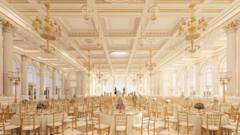The White House has revealed ambitious plans for a new $200 million ballroom, a project that reflects President Donald Trump's longstanding desire to expand event space within the historic residence. This luxurious ballroom, designed to host around 650 guests, will be integrated into a redesigned East Wing, which currently accommodates offices for First Lady Melania Trump and other key personnel. Funding is set to be sourced from Trump and anonymous donors, with groundbreaking expected in September, as confirmed by Press Secretary Karoline Leavitt.
Many significant White House events currently take place in the East Room, which has a much smaller capacity of approximately 200. The proposed ballroom is heralded as a vital and elegant addition that will ultimately replace the need for large, temporary tents set up for substantial gatherings, a situation often deemed unsightly, especially when hosting world leaders.
"Completion is projected to occur well ahead of the end of Trump's term in January 2029," Leavitt stated, reflecting the administration's commitment to enhancing the White House's functionality while maintaining its historical essence. Chief of Staff Susie Wiles emphasized that the initiative intends to honor the White House's legacy while providing a remarkable venue for future administrations to utilize.
Architectural renderings suggest the ballroom will harmonize with the existing aesthetic of the White House, featuring exquisite elements such as chandeliers and ornate columns. Leslie Greene Bowman, who has been involved with the preservation of the White House under multiple presidencies, voiced her hopes that any renovations will respect the historical significance of the structure.
While the East Wing's current occupants will be temporarily relocated during the construction process, President Trump remarks that he has always been passionate about building and enhancing the White House, citing previous efforts that include ornamental improvements in the Oval Office and modifications to the Rose Garden. Trump has articulated his frustration with using temporary tents for significant events, calling it a "disaster."
This ballroom ambition has roots back to Trump's 2016 campaign, when he first offered to invest $100 million for such a project, a proposal that was reportedly dismissed amidst historical preservation concerns. As plans now progress, the envisioned ballroom symbolizes both a personal aspiration for Trump and a significant transformation of the White House's event capabilities.
Many significant White House events currently take place in the East Room, which has a much smaller capacity of approximately 200. The proposed ballroom is heralded as a vital and elegant addition that will ultimately replace the need for large, temporary tents set up for substantial gatherings, a situation often deemed unsightly, especially when hosting world leaders.
"Completion is projected to occur well ahead of the end of Trump's term in January 2029," Leavitt stated, reflecting the administration's commitment to enhancing the White House's functionality while maintaining its historical essence. Chief of Staff Susie Wiles emphasized that the initiative intends to honor the White House's legacy while providing a remarkable venue for future administrations to utilize.
Architectural renderings suggest the ballroom will harmonize with the existing aesthetic of the White House, featuring exquisite elements such as chandeliers and ornate columns. Leslie Greene Bowman, who has been involved with the preservation of the White House under multiple presidencies, voiced her hopes that any renovations will respect the historical significance of the structure.
While the East Wing's current occupants will be temporarily relocated during the construction process, President Trump remarks that he has always been passionate about building and enhancing the White House, citing previous efforts that include ornamental improvements in the Oval Office and modifications to the Rose Garden. Trump has articulated his frustration with using temporary tents for significant events, calling it a "disaster."
This ballroom ambition has roots back to Trump's 2016 campaign, when he first offered to invest $100 million for such a project, a proposal that was reportedly dismissed amidst historical preservation concerns. As plans now progress, the envisioned ballroom symbolizes both a personal aspiration for Trump and a significant transformation of the White House's event capabilities.




















